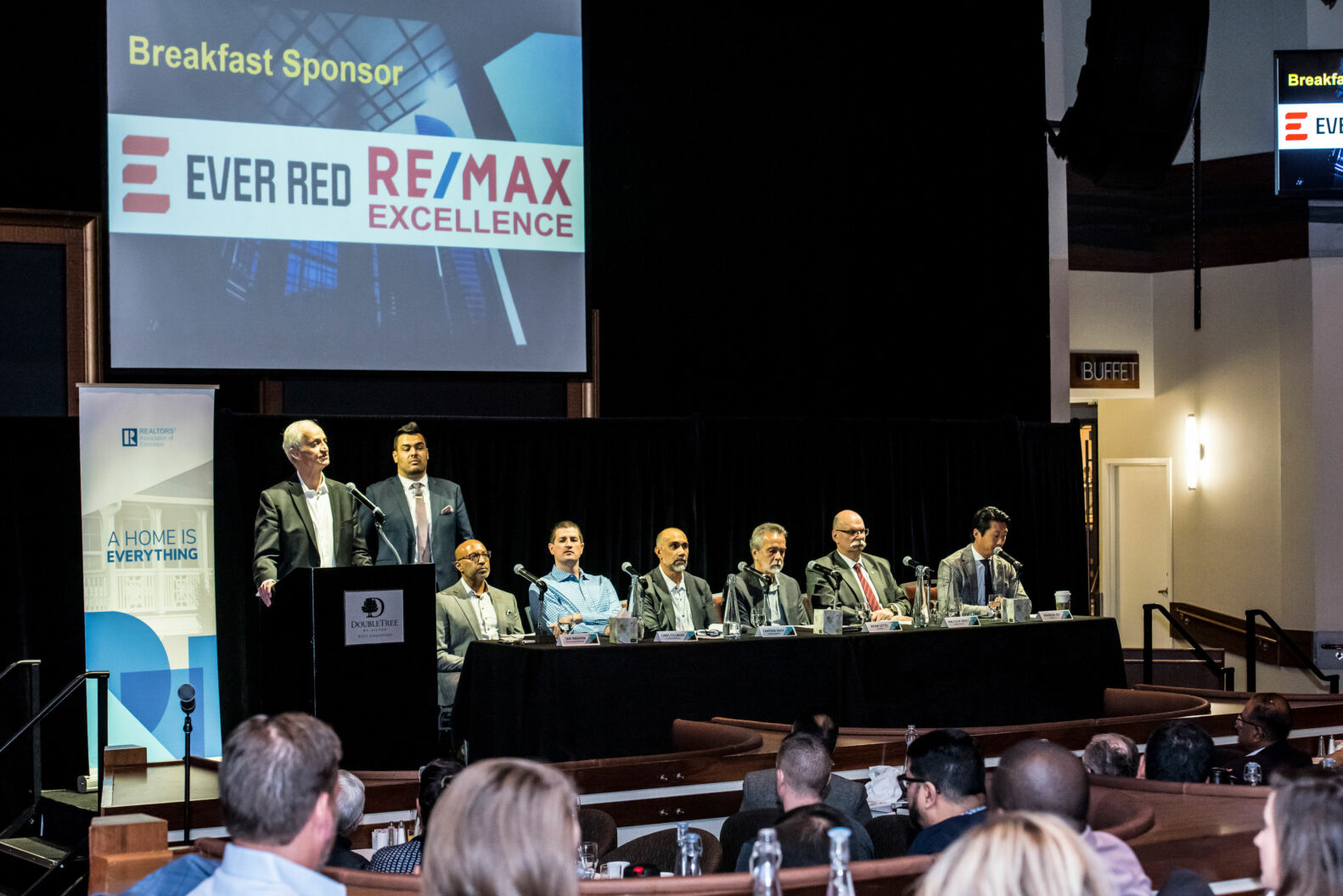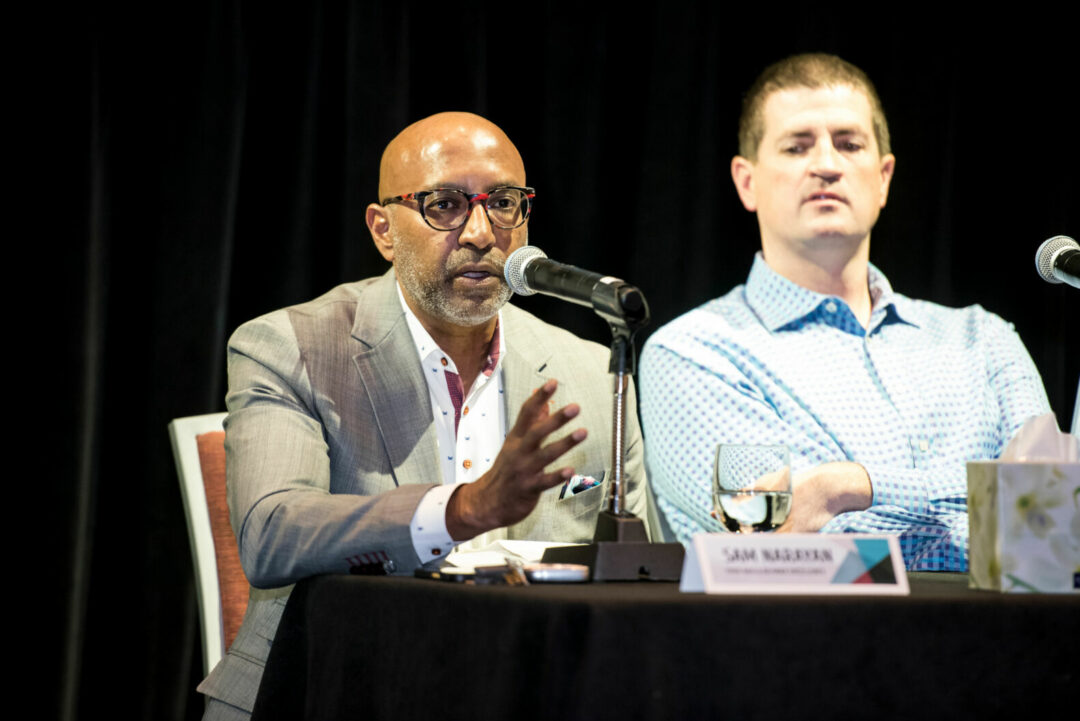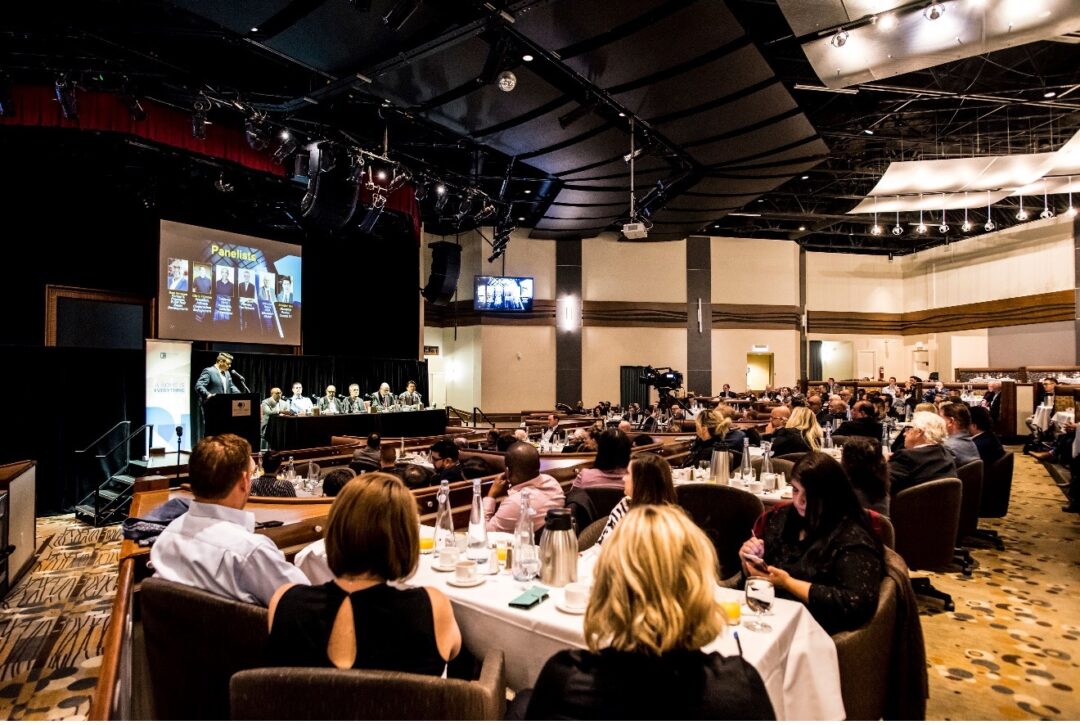
2022 RAE’s Commercial Panel Discussion Edmonton
Edmonton is well positioned for the upcoming economic slowdown, according to local real estate experts.
A panel of local real estate experts put Edmonton under the microscope last week at the RAE’s yearly Commercial Breakfast Panel Discussion, hosted by the REALTORS Association of Edmonton. Throughout the two-hour event moderated by Adel Hanafi, the panelists examined Edmonton’s response to interest rates, the forecasted 2023/2024 recession, employment and migration, the supply chain post-pandemic, and more. The reoccurring theme in each answer: Edmonton is well positioned to grow through the recession with real estate being the foundational industry that will drive the province’s growth.
Moderator & Host
Adel Hanafi – Vice President, Retail & Investment Sales & Leasing | RE/MAX Excellence Commercial Division
Panelists
Sam Narayan – Partner & President, EVER Real Estate Developments Ltd.
Chris Fillmore – President, Fillmore Construction Management
Cameron Naqvi – President, Cameron Corporation
Brain Gettle – Founder, The Network
Malcolm Bruce – CEO, Edmonton Global
Brandon Kot – Managing Partner, Canada ICI
“We are getting B’s, but we should be getting A’s” – Malcolm Bruce, Edmonton Global
A unique voice on the panel as the spokesperson for the Edmonton Region’s economic development, Bruce cited numerous examples of how the Alberta economy will lead the country in GDP growth. Outside of the traditional oil and gas sectors, the Edmonton region is receiving international recognition as Port Alberta, an epicentre of Hydrogen production, world class education facilities and a leader in agriculture.
- Don Patterson, Broker at RE/MAX Excellence, provided opening remarks and spoke about the “Edmonton Advantage” which includes affordability, diversification, and a tremendous growth trajectory.
• Malcolm Bruce commented on Edmonton as a global logistics hub and becoming known as Port Alberta that acts as a centre for rail and air connecting us to the rest of the world. - Our market is very strong in distribution and services logistics. Brian Gettel brought forward recent examples in the industrial distribution sector, namely the Amazon Centre in Acheson (2.9 million SF), Apex in Northeast Edmonton (500,000 SF); and an additional 600,000 SF building in Northeast Edmonton which will be occupied by The Brick and Leons.
- Currently, there are $30 billion on the books for hydrogen projects in Edmonton with the potential for this to become a $100 billion-year economy. Bruce explained that his is an area we can grow over the next few years with Edmonton becoming the epicentre of hydrogen in Canada. Next April, Edmonton will be hosting the world’s largest hydrogen convention.
- Bruce used the agriculture industry as just one example of Alberta’s untapped potential, citing the current $8.9 Billion in GDP in the agriculture industry for Alberta but 95% of which is produced and is unrefined. “So for every farm sale dollar spent, we get one dollar of value added. If we changed that to 3:1, we’d be adding an additional $10 Billion just in this region.”

Brandon Kot, Canada ICI speaking at RAE Commercial Panel. Photo credit: REALTORS Association of Edmonton
“[Economic Forecasts] are predicting slowdowns for almost all the provinces, but the leader of the pack is going to be Alberta… This bodes well for our real estate market,” – Brian Gettel, The Network
Edmonton’s employment demand was cited by many panelists as an issue, but the solution (migration) is well within reach.
- According to Gettel, a 4.3% unemployment rate due to baby boomers moving out of the labor market, requires the province to source people from across the country and internationally.
- Chris Fillmore talked about how migration is a critical opportunity to fill gaps in employment and address the labor shortage. The current projection is that Alberta’s population over the next 30 years could increase between 70% and 100%, and most of those will find themselves in Edmonton or Calgary. There is an enormous growth opportunity in Edmonton compared to other metro areas due to their lack of land to expand and build upon. In Alberta, we can just keep building outward without costs rising dramatically.
- Bruce mentioned that the Edmonton metropolitan region has the second youngest region in Canada next to Saskatoon, with a mean average age of only 36.8. He also cited that 84.6% of new immigrants that come to Alberta, stay in Alberta. They feel included and a part of the community.
“There is a spotlight on Alberta, especially for national tenants” – Cameron Naqvi, Cameron Corporation
Both developers on the panel – Cameron Developments and EVER Real Estate Developments – echoed the trend that national retail tenants are looking to the Edmonton region to launch new locations. Most recently two of America’s popular restaurant chains PF Chang’s and California Pizza Kitchen launched their first Alberta locations in Edmonton with Chipotle and Chick-a-Fil also shopping for locations. So why is retail so strong in Edmonton?
- Our trade area is significant. We see big box stores such as Costco, Walmart and Golf Town having some of their most successful stores are in Edmonton. “People forget that our trade area is drawing all of Northern Saskatchewan, Northern Alberta, and Northwest Territories, and Edmonton is the hub that everyone comes into,” said Cameron. No sales tax, and high disposable income means that consumers spend more, making it a great test market.
- EVER Real Estate Developments cited their project EVER Square and noted that there will be some national names making their debut in the Edmonton market. Located on the main roadway between EIA and downtown Edmonton, the site is seen by regional and international traffic entering the city.
- Fillmore also commented on the project, stating that “I truly feel that is going to be the ignition Edmonton need to finally clean up the Calgary Trail route because that has been far to run down for too long for our main route into the city.”

Sam Narayan, EVER Real Estate Developments commenting on relationship with tenants and a post-covid market. Photo credit REALTORS Association of Edmonton.
“Today the tenants business plan and cash flow statements are more substantive.” – Sam Narayan, EVER Real Estate Developments & RE/MAX Excellence
What one panelist called the “Black Swan Event”, the post-covid conditions, and how that has affected the way each institution does business was also discussed. An underlying theme was that in Alberta, businesses are resilient, and those who were able to adjust are in a good position.
- “We’re not having covid conversations anymore with our tenants, the conversation we have is about the strength of the covenants,” said Narayan.
- From the lender’s perspective, Covid challenged the notion of business ethics. “Lenders have a long memory in terms of the businesses who were forthright about the status of their development and what their portfolios were, and the ones who were not as communicative” From that perspective, integrity, trust, and transparency are what is more underwritten now.
- Fillmore commented that owners are more and more looking to understand the cost of construction and are being creative with efficiencies and cost savings. The opportunity is for developers and construction management firms to work more closely together at an earlier stage of development to mitigate some of the project risks, and to share the risk and the reward when it comes to supply availability and price.
“Real estate is a long-term business, it’s about time in the market, not timing the market.” – Brandon Kot, Canada ICI
- With the rise of interest rates, there is a negative impact on the value of investment properties. With interest rates continuing to rise, Gettel commented that there has been upward pressure on CAP Rates, anywhere from 0.75% to 1.5%.
- For developers and investors, the yield is what Edmonton markets have presented in the past, but its tighter than what we have ever seen. However, working to meet the development yield is met through fine-tuning costs, increasing NOI and looking at the long term of the project. “We expect to meet our development yield in year three instead of year one,” said Narayan.
- Naqvi shared some conclusions based on Cameron Development’s relationship with pension funds and REIT partners, that there is hesitation on when to invest and they are waiting to see if interest rates rise and CAP rates keep climbing, but ultimately real estate is an area to invest.
- Real estate is a hedge against inflation, but it is not in real-time, it is long-term. The asset classes that are keeping pace with inflation and are seeing modest rental growth are multifamily and spec industrial, commented Kot.

“Information has become so much more important.” – Chris Fillmore, Fillmore Construction
In a high-interest, post-pandemic economy, businesses are making longer-term strategies to make project yields work. However, mitigating risk and using caution has never been more important. Fillmore brought to attention the significant fluctuations in materials cost, and the implications for developers.
- You have examples like glass; there are four major glass providers in all of North America, and whether by collusion or by incredible coincidence, all four of them decided within a week of each other to raise the price of glass by 40% overnight, then 100% over the last year. Keeping an eye on commodity data is increasingly important because things have changed so much.”
- Information also has its place in bringing business to Alberta, which is the main objective of each of the panelist’s businesses. The various advantages and opportunities of the Edmonton Region, as brought forward by Bruce, were noted as being essential pieces that should be carried into conversations with clients, and the benefits of the province need to be better understood by the rest of Canada.